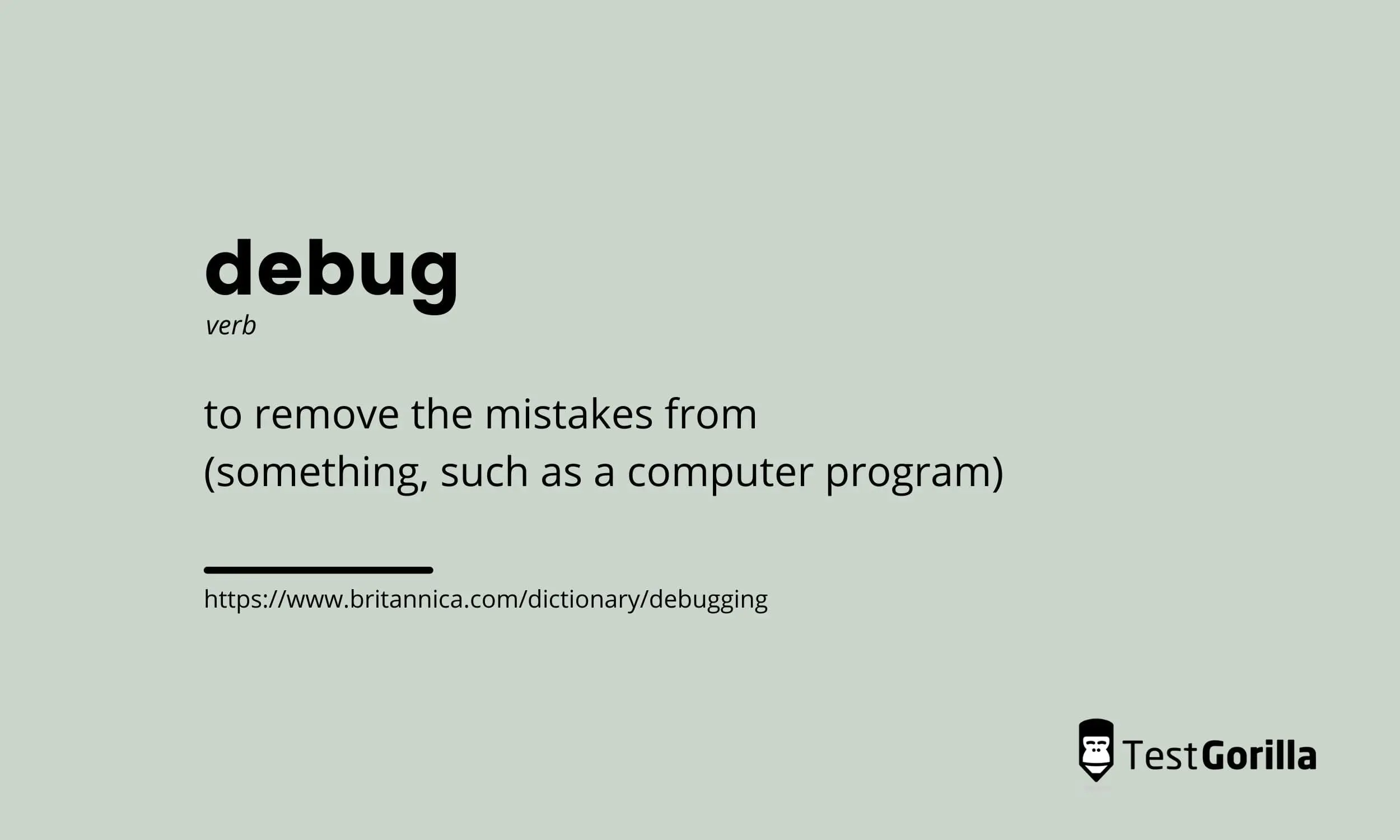Debugging is an inherent skill of many developers. However, nobody is perfect, so it’s common for some bugs to slip through the cracks.
As such, it only makes sense for developers to carefully assess their own work and find solutions to the bugs they unintentionally create.
JavaScript developers who can understand and debug code stand out from the rest. As a recruiter, you must hire a developer who can identify and fix errors in their own code or code written by other developers.
Typically, debugging skills tests are instrumental in finding such developers, and you should incorporate them into your screening process. Furthermore, debugging tests are more effective than other programming and critical-thinking tests at evaluating debugging skills specifically.
[
Hence, our aim in this article is to show you how to assess debugging skills and to describe the benefits of this practice.
We’ll also cover the types of debugging strategies available to give you an idea of what to look out for when hiring JavaScript developers.
Table of contents
What is debugging?
Debugging is a software programming process for discovering and solving errors – usually referred to as “bugs” – in a website or software application. In other words, debugging is the process of fixing bugs in the software.
Debugging begins after the developer notices that the software or website fails to execute correctly and concludes when they find a solution. The developer tests the software to identify errors that decrease the efficiency and reliability of a program.
Why do we need debugging?
Debugging is vital because it enables software developers to fix errors in a website or software application before releasing it to the public, improving your customers’ satisfaction with your software.
Detecting errors early on makes software development easier and less stressful. Debugging also helps improve the quality of your software product, which could increase the number of positive reviews you get.
Although debugging is often a tedious task to undertake, it’s a great way to bolster your customer experience by fixing the errors your program or website might have.
Advantages of debugging in JavaScript
Improving the reliability and efficiency of software requires developers to understand why it behaves the way it does.
As a recruiter, knowing the advantages of debugging will aid you in assessing potential candidates for JavaScript developer roles.
Below are some advantages of debugging:
Saves time: Carrying out JavaScript debugging exercises early on in the software development process saves software engineers time and helps them avoid working with bug-ridden code.
Error reports: Debugging gives you the opportunity to report errors as soon as they occur, making the software development process stress free.
More accessible interpretations: Debugging provides more information about data structures, making them easier to interpret.
Bug-free software: Finding errors in the application before its release enables your customers to enjoy bug-free software.
Steps involved in JavaScript debugging
To understand how to properly assess the debugging skills of a JavaScript developer, you should know what steps make up the debugging process.
Read on to learn about the process of debugging:
1. Identify the bug
Bugs can often be misleading and hard to interpret. As such, it’s essential to accurately identify an error to understand the actual cause of the problem.
2. Find the location of the bug
At this stage, you are focused on finding the bug’s location rather than understanding the reason behind the error.
After identifying the error, you need to discover the exact location in the code the bug occurs. This way, you can narrow down the problem and start analyzing its cause.
3. Analyze the bug
Analyzing a bug means determining what is causing the error. It also involves two other tasks: checking around the bug for other errors and ensuring that your fix doesn’t result in collateral damage.
In this step, you are focused on understanding and analyzing the problem.
4. Prove the analysis
Once you have analyzed the primary bug, you need to run automated tests to verify that your analysis was correct. This also gives you an opportunity to locate any other errors that may appear in the application.
5. Deal with collateral damage
This stage requires you to gather all the unit tests for the code you’re going to make changes to. If all of these tests pass, you can move on to the next stage. Otherwise, you must resolve any test cases that do not pass.
6. Fix and validate the bug
The final stage is fixing all the bugs and running all the test scripts to see if they pass. Using multiple tests will help you find the solution to the error, enabling you to deal with it again if the same bug occurs in the future.
4 JavaScript debugging strategies
Debugging is one of the most ingenious and intellectual aspects of creating software. Although it can be difficult, having effective debugging strategies will help you debug faster.
Below are four debugging strategies:
1. Study the software
It’s critical for JavaScript developers to study the software or product deeply to understand its structure. Without deep knowledge of the system’s code, they can’t find errors.
2. Use past experience
Previous experience will help JavaScript developers find and resolve bugs in their code. How developers use their experience to check for problems in the software will depend on their specific expertise.
3. Perform forward analysis
This strategy focuses on the regions where wrong outputs occur. Forward analysis entails tracking a program forward using breakpoints or print statements at different points in the program.
4. Perform backward analysis
Finally, backward analysis involves tracking the program backward from the location of failure to identify the location of the incorrect code. A JavaScript debugger needs to thoroughly study the area where the defect occurs to find the cause.
Combine debugging problems with skills testing
One of recruiters’ many fears is that bringing online JavaScript exercises into the recruitment process might limit their ability to assess candidates’ JavaScript skills.
How do you assess debugging skills?
One of the best methods is to present them with a real-life situation that requires them to fix a bug and see how they go about finding a solution.
You can also give them a piece of code that contains bugs and ask them to find the errors and explain how to fix them.
Skills tests are another great strategy for assessing candidates’ JavaScript debugging skills. By using a JavaScript debugging test, you can find out which applicants have the best debugging abilities objectively and without bias.
Get started with TestGorilla for free today to start using skills tests in your hiring process.
Related posts
Hire the best candidates with TestGorilla
Create pre-employment assessments in minutes to screen candidates, save time, and hire the best talent.
Latest posts
The best advice in pre-employment testing, in your inbox.
No spam. Unsubscribe at any time.

Hire the best. No bias. No stress.
Our screening tests identify the best candidates and make your hiring decisions faster, easier, and bias-free.
Free resources
This checklist covers key features you should look for when choosing a skills testing platform
This resource will help you develop an onboarding checklist for new hires.
How to assess your candidates' attention to detail.
Learn how to get human resources certified through HRCI or SHRM.
Learn how you can improve the level of talent at your company.
Learn how CapitalT reduced hiring bias with online skills assessments.
Learn how to make the resume process more efficient and more effective.
Improve your hiring strategy with these 7 critical recruitment metrics.
Learn how Sukhi decreased time spent reviewing resumes by 83%!
Hire more efficiently with these hacks that 99% of recruiters aren't using.
Make a business case for diversity and inclusion initiatives with this data.




















